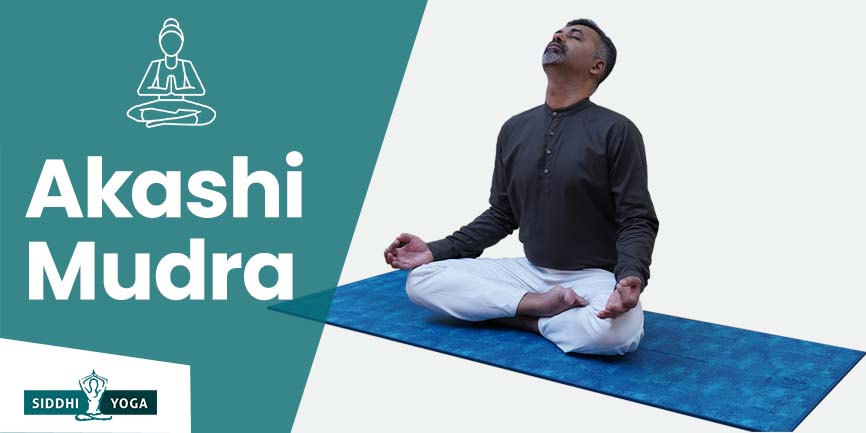
Discover the meaning, how to do, and benefits of the Akashi Mudra hand gesture, and learn how you can use it to improve your yoga practice.
Definition – What is Akashi Mudra and its Meaning, References, and Mythology?
Akashi Mudra is a Mudra of “Awareness of Inner Space” or “Consciousness of Inner Space.”
As per the Sanskrit Sloka:
“Yat Pinde Tatt Brahmande”
Which can be translated as our body being made of the same materials that this entire Universe is made of.
Or we can also translate it as:
You are a universe within this Universe.
Hence, this Consciousness of Inner Space is so important.
Akashi Mudra is a type of Mudra or Gesture/seal in which we focus on an external object and concentrate on it. Akashi Mudra is more related to Dharna (Concentration) that can further culminate into Dhyana (Meditation).
Let us understand its meaning by breaking this Mudra into two different words:
Akashi – The Sanskrit word “Akashi” comes from Akash (Sky). The word Akashi represents Sky (Akash) as a place where we concentrate our gaze.
Mudra – As we know, “Mudra” represents a seal or gesture, or lock.
So, when we practice this Mudra, we constantly gaze toward the sky, hence the name Akashi Mudra. But Akashi Mudra should not be confused with Akash Mudra. Akash Mudra is a type of Hasta Mudra or hand gesture/seal. On the other hand, Akashi Mudra is often considered as Mana Mudra or head gesture which has more emphasis on the gaze.
This Mudra should be practiced while sitting in a seated Meditation posture as this requires a high concentration level. Practicing it while standing in a posture could lead to dizziness or loss of balance. As this Mudra requires gazing upward towards the sky, people with cervical spondylosis can feel dizziness, so it is advised that you avoid keeping your head too much back bending in case of any discomfort or if you experience dizziness, etc.
This Mudra is also believed to positively influence the Visuddhi Chakra (Throat Chakra) and Sahastrara Chakra (Crown Chakra). As mentioned earlier, neck movement stimulates the throat Chakra, which also stimulates the thyroid glands in our neck region. This Mudra practice also brings a balance between the Nadis.
Alternate Names of Akashi Mudra
Head Mudra or Mana Mudra, Awareness of Inner space Mudra.
How to Do Akashi Mudra?
- This is considered one of the Mana Mudras or the Head gestures. While practicing this Mudra, we keep a constant gaze at the sky. We concentrate on an external object which happens to be the sky.
- To practice this Mudra, we can start by sitting in any meditative posture, such as Vajrasana (Thunderbolt Pose), Sukhasana (also known as Easy Pose), or Padma Asana (the Lotus Pose).
- Rest both of your hands comfortably on your knee. Palms are facing downward towards the ground, or you can keep a slight grip on your knee.
- Gently close your eyes and take a few deep breaths. Relax your entire body.
- Now, fold your tongue and place it on your upper palate in Khechri Mudra.
- Then, practice Sambhavi Mudra along with Ujjayi Pranayama for a while.
- Now, deep inhale and bend your neck backward at a 45-degree angle.
- Then, while keeping your elbows locked entirely, extend your arm comfortably.
- Inhale deeply and exhale completely while practicing the Ujjayi breathing. Gaze towards the sky.
- Retain it as long as you can.
- When you are done with your practice, start coming back with an exhalation. Step by step, release the Khechri Mudra and then Shambhavi Mudra.
- Then slowly start to bring your neck back in the upright position and gradually discontinue the Ujjayi breathing.
- Make sure to practice the counter-balancing Mudra that is Jalandhar Bandha as well.
- Practicing it 3-5 times a day is sufficient.
Akashi Mudra Benefits

- This Mudra practice brings an awareness of Inner space. Hence this Mudra is also named “Awareness of Inner space Mudra.” According to Yogic philosophy, Inner space is as important as outer space.
- This Mudra practice helps to balance the Nadis.
- This Mudra practice helps to activate the Thyroid glands. If practiced along with Jalandhar bandha or chin lock, it will improve thyroid gland functioning to a great extent.
- It helps to control our senses and brings a state of calmness. When we have better control over the senses, it helps to control mental hurdles in life. It also helps to uplift our thoughts.
- It also stimulates the Crown Chakra ( Sahastrara Chakra) and the throat Chakra (Visshuddhi Chakra).
Akashi Mudra Precautions and Contraindications

- Do not practice this Mudra in a polluted environment. This can harm your body, especially the lungs.
- Make sure to practice counter-balancing Mudra, the Jalandhar Bandha Mudra, or the chin lock.
- People with high blood pressure, vertigo, etc., should avoid practicing this Mudra.
- If you have issues related to the cervical region, such as cervical spondylosis, consider practicing it with caution.
- If you experience dizziness, consider releasing the Mudra and relaxing in Shavasana.
- Do not consider practicing this Mudra in a standing posture.
- Make sure to practice this Mudra without getting any sense of discomfort.
When and How long to do Akashi Mudra?
- If you want to improve your mental health, then this Mudra practice will help you to do that.
- If you want to stimulate your Crown Chakra and Vishuddhi Chakra (throat Chakra), practicing this will help.
- If you have thyroid gland-related issues, then practicing it will help to get improved results.
Morning is the ideal time to do any yoga or Mudra. In the morning, at this time during the daytime, our brain is at its best. So, you are more likely to be able to concentrate easily. Therefore, you should practice this Mudra from 4 am and 6 am to get the most effective outcomes.
If you are having difficulty with this during the morning, you can do this Mudra later in the evening too.
Practicing this Mudra for a minimum of 20-40 minutes daily is recommended. Whether you wish to complete it in one stretch or two threes that last between 10 and 15 minutes, it’s up to you. Based on research, the best way to practice an exercise for at least 20 minutes is to get the best benefits of that particular Mudra.
Breathing in Akashi Mudra
To enhance your practice, you can practice breathing techniques with this Mudra.
- If this Mudra is practiced in conjunction with Ujjayi breathing, it will enhance its effects.
Affirmation in Akashi Mudra
You can keep an intention of the practice:
“Whenever I look at the sky, it fills me with positivity.”
Conclusion
The Akashi Mudra is a simple yet powerful gesture that has many benefits. Incorporating this Mudra into your daily life can improve your physical and mental health. If you’re interested in learning more about mudras and how to use them effectively, consider taking our Mudras Certification Course. This course includes 108 mudras, each with its specific purpose and benefit. With the help of this course, you can learn how to use mudras to improve your overall health and well-being.